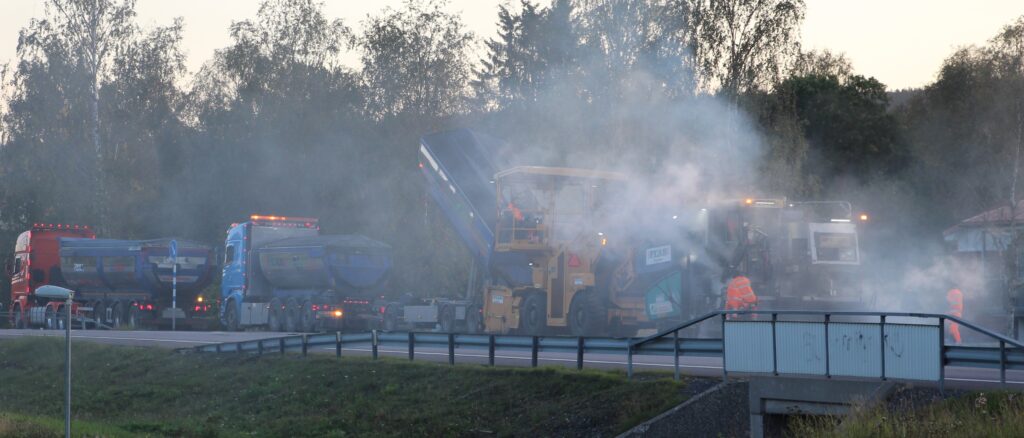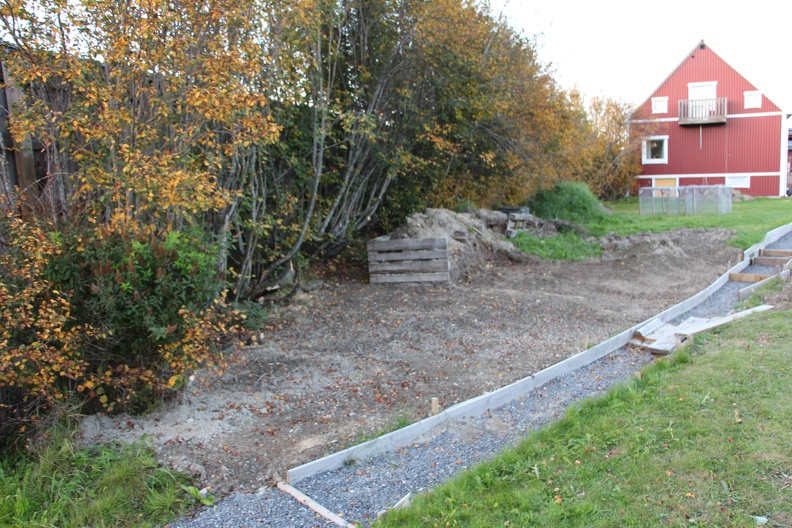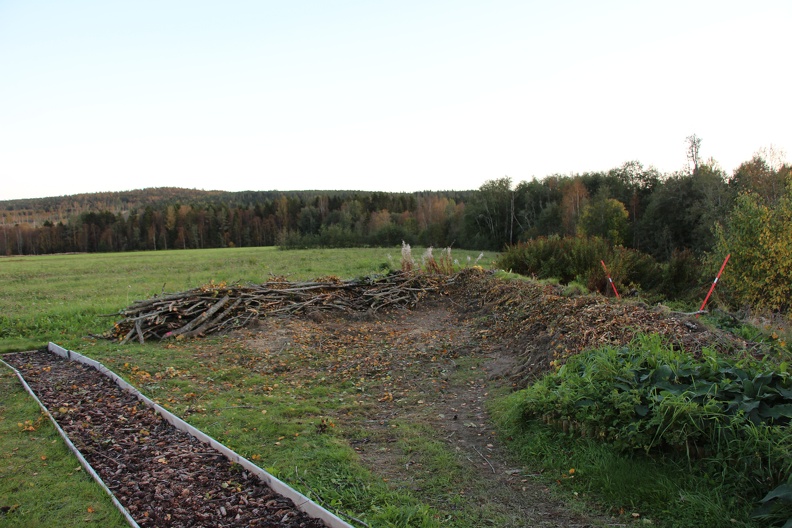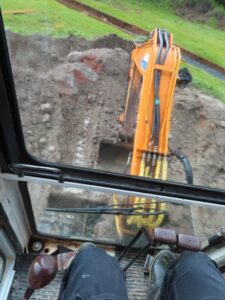2023-09 Earthworks
This month we conducted mostly earthworks. We were desperately trying to get significant changes done to the garden before the winter with the time and resources we had. Rain made it too wet to work with the digger without causing significant damage. At one point I got frustrated and used the digger anyway, and caused a lot of scarring on the land from the tracks for not much work achieved.
Road Resurfacing
One of the most significant roads in Sweden goes past our house. It is one lane in either direction, through the village. This year they resurfaced both sides of the road. A regimented line of industrial vehicles did the resurfacing. At the front a vehicle ripped up the top layer of road surface. An excavator unloaded this material into dumper trucks that carrier it to the back of the convoy. A vehicle further down then took the material and mixed it with tar, before depositing it on the road. Then following vehicles prepared and compressed the new surface. A coordinating team at either end allowed traffic though the single lane past the convoy, in waves. I was impressed with the operations speed and organisation.

Returning the Mini Digger
We had been loaned a mini-digger by a local friend. It had proved really useful. Another friend needed earth for his land, and we had a massive pile left behind from excavating the greenhouse footings. So on occasions his trailer would arrive and we would fill up the trailer with the mini digger.
But ideally we should have known to have prepared some kind of assisting vehicle or similar to transport the earth around the garden. With a larger excavator that one might see at a building site, no assistance might be needed as you might be able to reach across the site by sitting in the middle and moving the arm. You can also move a pile by “leapfrogging” – digging and placing, then moving the digger and repeating until the earth pile is where you wanted it, but that would take a long time and cause a lot of mess. Ideally the minidigger would be accompanied by a small tipper vehicle, but these start at about €/£/$5000 and I couldn’t justify it.
In the final weeks left to use the digger, we used my girlfriend digging, placing earth in wheelbarrows and myself moving and emptying the wheelbarrows. We did this in the evenings after work which meant there were a lot of mosquitos, but we managed to remove all piles that had resulted from the construction of the footpath.
We made sure to clean the mini digger and refill the diesel tank before our friends collected it.
Digging trench
One of my tasks was to dig a trench so that I could lay a powerline to the greenhouse. We had left this until last because it would create a barrier that the minidigger and wheelbarrows could not cross. There was a lot of debate as to where this should go and how it might serve a dual purpose such as a gravel path above. The normal way to dig this would be to put the digger in line with the intended trench, and dig towards the digger, moving the digger along the line. We couldn’t do this as a greenhouse was at one end and the existing path at the other, so the trench was imperfect and will need finishing by hand.
Planting tree
We also used the mini digger to excavate a hole, so that we could plant a new tree. We had kept a tree in the greenhouse for the summer but wanted to plant it before winter. I softened the sides of the hole by hand with a spade, and added some manure from a neighbours horses. I put a drain pipe vertically in the hole so that we could water the tree roots directly.

Hedge Thinning
As the trees started to lose their leaves it was the right time to thin the hedgeline back. The hedge has grown quite tall and wide. I thinned it with a chainsaw by cutting down roughly every fifth upright. We used a mulcher on the smaller branches. As the hedge becomes made out of younger growth, so it will become possible to “lay” the hedge in future years, which should be interesting.
The following photo is a little blurry, but shows the levelled earth area with hedges being thinned. We seeded the levelled area with grass seed which should become a lot denser in spring.

Hügelkultur
An old bonfire site lies at the far end of the garden. We removed all historic debris we could find and dug the area over with the digger. We checked the boundary maps and spoke with the neighbour but had to be careful as the corner metal boundary marker pole didn’t seem to be present. I used the brush cutter to cut back the wild bushes to try to find the marker. It is possible it was removed by ploughing. As a temporary measure I marked the likely boundary with red marker poles so they were obvious when levelling.
We used the waste soil from digging to level off the land on our side of the likely boundary line. Once the land was level we used the largest branches and spare earth to create a “Hügelkultur” raised berm. The idea was to try and give a little protection to the garden, and also an interesting feature. It might also be a potential site to plant permanent trees on in future years.

It’s likely that we will need to confirm the boundary here in the future before we do anything significant. A boundary re-marking would cost us approximately 5000SEK (roughly £4,000/$4,000) for the official surveyor. That would be a large budget hit that I have been reluctant to invest in. Currently we can fix any mistake with a mini digger.
Northern lights
A surprise was the northern lights being visible earlier than expected this year. My girlfriend noticed them at 3am one night and I took some pictures, but I wasn’t prepared and was half asleep, fumbling for camera controls in the dark. The lights appeared as a dancing curtain, but I had the camera set to a long exposure mode that created a green haze in the resulting photo. I should have used a high ISO setting instead. The resulting photos weren’t as good as I would have liked.

